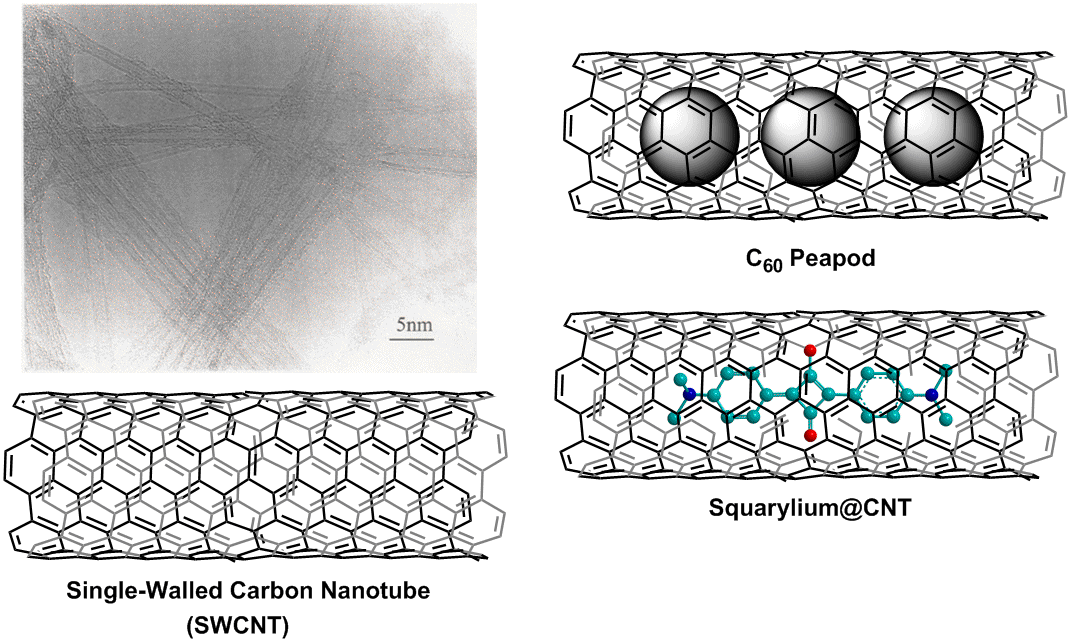Published TCIMAIL newest issue No.199 | Product Document Searching Made Easy by 2D Code! | [TCIPracticalExample] Ullmann-Type Coupling Reaction Using...
Maximum quantity allowed is 999
Please select the quantity
Carbon Nanotubes (CNTs) and CNT Dispersants
A carbon nanotube (CNT) has a cylindrical structure with a nanoscale diameter that is like a rolled graphene sheet. Iijima first observed a CNT in 1991.1) A CNT consists of only sp2 carbons similar to fullerenes. There are diverse CNTs on the basis of their length, diameter of the nanotube, state of chirality, and number of the layer. The variety of these structures provides various band structures and metallic and semiconducting properties.2,3) A normal synthetic procedure gives a mixture of semiconducting CNTs in 2/3 and metallic CNTs in 1/3, because rolling a carbon sheet occurs randomly. Since we need to obtain the semiconducting CNT in pure form in order to utilize the semiconductivity, improved synthetic procedure and efficient purification of CNT are further required.4-7)
Moreover, CNTs have high physical durability, high electrical and thermal conductivity, and are light and flexible. On the basis of such excellent characteristics, CNTs are expected to be field-effect transistor (FET) materials, nanoscale wire materials, electron emission sources, optical communication switches, chemical sensors, high strength composites, and thermal devices.8-10)
CNTs can enclose nanoscale molecules and atoms in the internal space, because of the cylindrical structure. For instance, there is a fullerene-enclosed CNT, the so-called ‘peapod’.11) In addition, CNTs can enclose metal, water, and molecular oxygen. Properties of the enclosed water in the CNT are different from those of bulk water.12,13) An organic dye (eg. squarylium) can be easily enclosed within the internal space of CNTs in solution. In this case, the enclosed squarylium dye absorbs light and then an energy transfer (sensitization) to the outer CNT occurs.14) Hydrogen storage using CNTs is expected to be used in the development of a fuel cell.15)
Moreover, CNTs have high physical durability, high electrical and thermal conductivity, and are light and flexible. On the basis of such excellent characteristics, CNTs are expected to be field-effect transistor (FET) materials, nanoscale wire materials, electron emission sources, optical communication switches, chemical sensors, high strength composites, and thermal devices.8-10)
CNTs can enclose nanoscale molecules and atoms in the internal space, because of the cylindrical structure. For instance, there is a fullerene-enclosed CNT, the so-called ‘peapod’.11) In addition, CNTs can enclose metal, water, and molecular oxygen. Properties of the enclosed water in the CNT are different from those of bulk water.12,13) An organic dye (eg. squarylium) can be easily enclosed within the internal space of CNTs in solution. In this case, the enclosed squarylium dye absorbs light and then an energy transfer (sensitization) to the outer CNT occurs.14) Hydrogen storage using CNTs is expected to be used in the development of a fuel cell.15)

References
- 1)S. Iijima, Nature 1991, 354, 56.

- 2)J. Kim, A. J. Page, S. Irle, K. Morokuma, J. Am. Chem. Soc. 2012, 134, 9311.

- 3)Review: Y. Miyato, J. MMIJ 2011, 127, 61.

- 4)M. Kawai, H. Kyakuno, T. Suzuki, T. Igarashi, H. Suzuki, T. Okazaki, H. Kataura, Y. Maniwa, K. Yanagi, J. Am. Chem. Soc. 2012, 134, 9545.

- 5)I. Ibrahim, A. Bachmatiuk, J. H. Warner, B. Büchner, G. Cuniberti, M. H. Rümmeli, Small 2012, 8, 1973.

- 6)B. Liu, W. Ren, S. Li, C. Liu, H.-M. Cheng, Chem. Commun. 2012, 48, 2409.

- 7)H. Liu, D. Nishide, T. Tanaka, H. Kataura, Nat. Commun. 2011, 2, 1313/1.

- 8)Review: K. Balasubramanian, E. J. H. Lee, R. T. Weitz, M. Burghard, K. Kern, Phys. Status Solidi A 2008, 205, 633.

- 9)J. Park, Y. Kim, G.-T. Kim, J. S. Ha, Adv. Funct. Mater. 2011, 21, 4159.

- 10)N. J. Kybert, M. B. Lerner, J. S. Yodh, G. Preti, A. T. C. Johnson, ACS Nano 2013, 7, 2800.

- 11)J. H. Warner, A. A. R. Watt, L. Ge, K. Porfyrakis, T. Akachi, H. Okimoto, Y. Ito, A. Ardavan, B. Montanari, J. H. Jefferson, N. M. Harrison, H. Shinohara, G. A. D. Briggs, Nano Lett. 2008, 8, 1005.

- 12)H. Kyakuno, K. Matsuda, H. Yahiro, Y. Inami, T. Fukuoka, Y. Miyata, K. Yanagi, Y. Maniwa, H. Kataura, T. Saito, M. Yumura, S. Iijima, J. Chem. Phys. 2011, 134, 244501.

- 13)J. M. H. Kroes, F. Pietrucci, A. Curioni, R. Jaafar, O. Gröning, W. Andreoni, J. Phys. Chem. C 2013, 117, 1948.

- 14)K. Yanagi, K. Iakoubovskii, H. Matsui, H. Matsuzaki, H. Okamoto, Y. Miyata, Y. Maniwa, S. Kazaoui, N. Minami, H. Kataura J. Am. Chem. Soc. 2007, 129, 4992.

- 15)E. Tylianakis, G. K. Dimitrakakis, F. J. Martin-Martinez, S. Melchor, J. A. Dobado, E. Klontzas, G. E. Froudakis, Int. J. Hydrogen Engergy 2014, 39, 9825.

Explore Carbon Nanotubes (CNTs) and CNT Dispersants Categories
- Home
- Products
- Materials Science
- Nanocarbon Materials
- Carbon Nanotubes (CNTs) and CNT Dispersants

